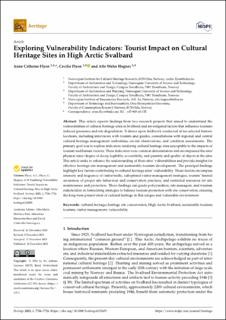Exploring Vulnerability Indicators: Tourist Impact on Cultural Heritage Sites in High Arctic Svalbard
Peer reviewed, Journal article
Published version

View/
Date
2023Metadata
Show full item recordCollections
- Publikasjoner fra Cristin [3256]
- SIFO andre publikasjoner [31]
Original version
Heritage — Open Access Journal of Knowledge, Conservation and Management of Cultural and Natural Heritage. 2023, 6 (12), 7706-7726. 10.3390/heritage6120405Abstract
This article reports findings from two research projects that aimed to understand the
vulnerabilities of cultural heritage sites in Svalbard and investigated factors that influence tourism-
induced pressures and site degradation. It draws upon fieldwork conducted at ten selected historic
locations, including interviews with tourists and guides, consultations with regional and central
cultural heritage management authorities, on-site observations, and condition assessments. The
primary goal was to explore indicators rendering cultural heritage sites susceptible to the impacts of
tourism and human visitors. These indicators were common denominators and encompassed the sites’
physical state/degree of decay, legibility, accessibility, and quantity and quality of objects at the sites.
This article seeks to enhance the understanding of these sites’ vulnerabilities and provide insights for
effective heritage site management and sustainable tourism development. The principal findings
highlight key factors contributing to cultural heritage sites’ vulnerability. These factors encompass
intensity and frequency of visitor traffic, suboptimal visitor management strategies, tourists’ limited
awareness of proper site behaviour and conservation practices, and restricted resources for site
maintenance and protection. These findings can guide policymakers, site managers, and tourism
stakeholders in formulating strategies to balance tourism promotion with site conservation, ensuring
the long-term preservation of cultural heritage in this unique and vulnerable environment.
